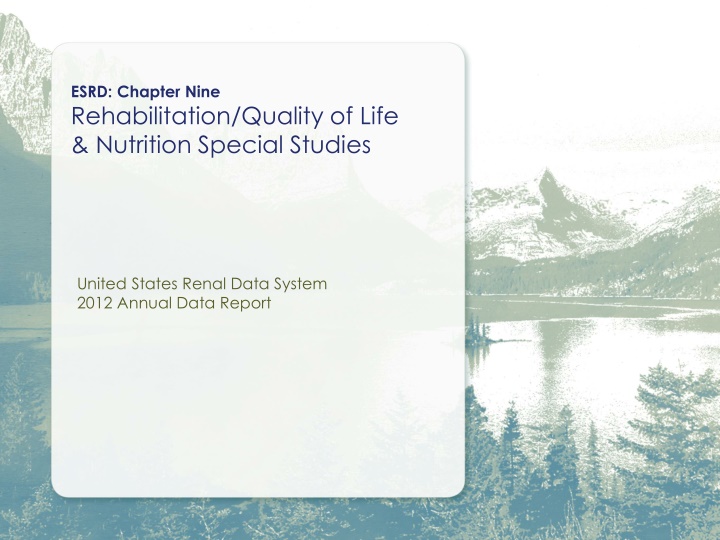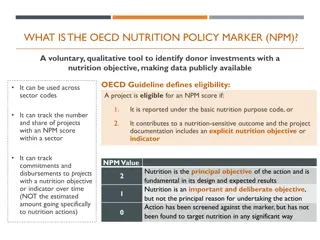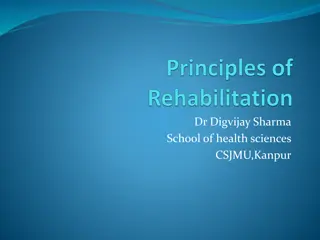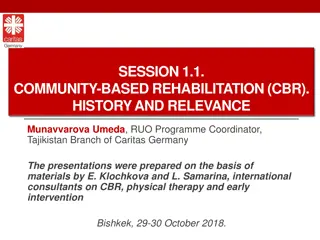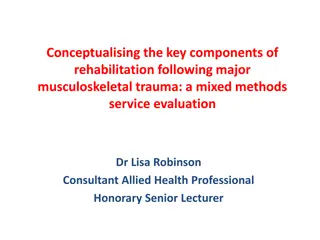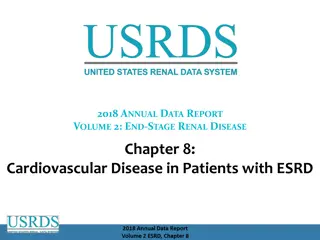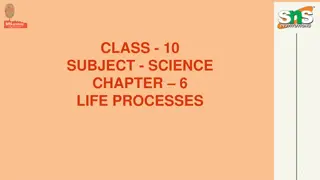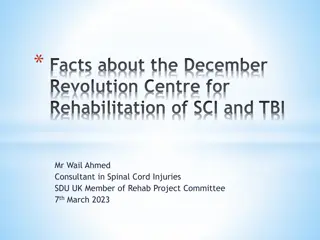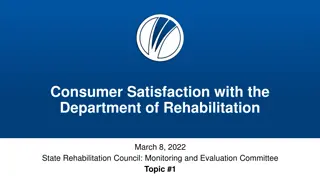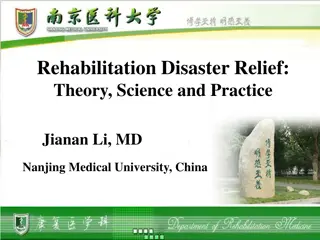Insights from USRDS 2012 Annual Data Report on Rehabilitation, Quality of Life, and Nutrition
The USRDS 2012 Annual Data Report sheds light on various aspects of rehabilitation, quality of life, and nutrition in patients undergoing dialysis treatment. It includes valuable information on patient activity, sociodemographic characteristics, awareness of peritoneal dialysis, and selection trends based on ownership and ESRD network. The report provides a comprehensive overview of CDS participants who started treatment between June 1, 2005, and June 1, 2007, offering insights into their experiences and care.
Download Presentation

Please find below an Image/Link to download the presentation.
The content on the website is provided AS IS for your information and personal use only. It may not be sold, licensed, or shared on other websites without obtaining consent from the author.If you encounter any issues during the download, it is possible that the publisher has removed the file from their server.
You are allowed to download the files provided on this website for personal or commercial use, subject to the condition that they are used lawfully. All files are the property of their respective owners.
The content on the website is provided AS IS for your information and personal use only. It may not be sold, licensed, or shared on other websites without obtaining consent from the author.
E N D
Presentation Transcript
ESRD: Chapter Nine Rehabilitation/Quality of Life & Nutrition Special Studies United States Renal Data System 2012 Annual Data Report
Distribution of CDS participants Figure 9.1 (Volume 2) CDS participants who started treatment between June 1, 2005, & June 1, 2007. USRDS 2012 ADR
Patient activity & quality of life questionnaire Table 9.a (Volume 2) CDS participants who started treatment between June 1, 2005, & June 1, 2007. USRDS 2012 ADR
Sociodemographic characteristics of Comprehensive Dialysis Study participants Table 9.b (Volume 2) CDS participants who started treatment between June 1, 2005, & June 1, 2007. USRDS 2012 ADR
Patients reporting or not reporting early awareness (pre-dialysis) of peritoneal dialysis, by age, gender, race, diabetes, education, and treatment site. Figure 9.2 (Volume 2) CDS participants who started treatment between June 1, 2005, & June 1, 2007. USRDS 2012 ADR
Patients reporting or not reporting awareness of peritoneal dialysis, by employment, & nephrology care Figure 9.3 (Volume 2) CDS participants who started treatment between June 1, 2005, & June 1, 2007. USRDS 2012 ADR
Peritoneal dialysis selection among CDS participants, by dialysis unit ownership Figure 9.4 (Volume 2) CDS participants who started treatment between June 1, 2005, & June 1, 2007. USRDS 2012 ADR
Peritoneal dialysis selection among CDS participants, by ESRD network Figure 9.5 (Volume 2) CDS participants who started treatment between June 1, 2005, & June 1, 2007. USRDS 2012 ADR
Patients reporting or not reporting early awareness of kidney transplantation, by patient characteristics, & employment status Figure 9.6 (Volume 2) Incident dialysis patients who started treatment June 1, 2005 to June 1, 2007. USRDS 2012 ADR
Patients reporting or not reporting early awareness of kidney transplantation, by age, care, insurance status & education Figure 9.7 (Volume 2) Incident dialysis patients who started treatment June 1, 2005 to June 1, 2007. USRDS 2012 ADR
Time to wait listing in patients with early awareness of kidney transplant options Figure 9.8 (Volume 2) Incident dialysis patients who started treatment June 1, 2005 to June 1, 2007. USRDS 2012 ADR
Patients wait-listed or who received a deceased donor kidney transplant within one year of ESRD initiation Table 9.c (Volume 2) Incident dialysis patients who started treatment June 1, 2005 to June 1, 2007. USRDS 2012 ADR
Maximum activity scores (MAS) in CDS participants: males Figure 9.9 (Volume 2) Incident dialysis patients who started treatment June 1, 2005 to June 1, 2007. The boxes represent the 25th to 75th percentiles with the line in the center indicating the 50th percentile. Lines above and below extend to the 99th and 1st percentile, respectively. In each figure, scores are shown by age group, beginning with age <40 and progressing by decade to age 70+ years. Within each age group, normative data are represented on the left and CDS participants data are plotted on the right. USRDS 2012 ADR
Maximum activity scores (MAS) in CDS participants: females Figure 9.9 (continued Volume 2) Incident dialysis patients who started treatment June 1, 2005 to June 1, 2007. The boxes represent the 25th to 75th percentiles with the line in the center indicating the 50th percentile. Lines above and below extend to the 99th and 1st percentile, respectively. In each figure, scores are shown by age group, beginning with age <40 and progressing by decade to age 70+ years. Within each age group, normative data are represented on the left and CDS participants data are plotted on the right. USRDS 2012 ADR
Adjusted activity scores (AAS) in CDS participants: males Figure 9.9 (continued Volume 2) Incident dialysis patients who started treatment June 1, 2005 to June 1, 2007. The boxes represent the 25th to 75th percentiles with the line in the center indicating the 50th percentile. Lines above and below extend to the 99th and 1st percentile, respectively. In each figure, scores are shown by age group, beginning with age <40 and progressing by decade to age 70+ years. Within each age group, normative data are represented on the left and CDS participants data are plotted on the right. USRDS 2012 ADR
Adjusted activity scores (AAS) in CDS participants: females Figure 9.9 (continued Volume 2) Incident dialysis patients who started treatment June 1, 2005 to June 1, 2007. The boxes represent the 25th to 75th percentiles with the line in the center indicating the 50th percentile. Lines above and below extend to the 99th and 1st percentile, respectively. In each figure, scores are shown by age group, beginning with age <40 and progressing by decade to age 70+ years. Within each age group, normative data are represented on the left and CDS participants data are plotted on the right. USRDS 2012 ADR
CDS participants classified as frail, by age, gender, & race Figure 9.10 (Volume 2) Incident dialysis patients who started treatment June 1, 2005 to June 1, 2007. USRDS 2012 ADR
Frequency & severity of individual insomnia symptoms in CDS participants Figure 9.11 (Volume 2) Incident dialysis patients who started treatment June 1, 2005 to June 1, 2007. USRDS 2012 ADR
CDS participants with at least one severe symptom of insomnia, by age, gender, & race Figure 9.12 (Volume 2) Incident dialysis patients who started treatment June 1, 2005 to June 1, 2007. USRDS 2012 ADR
CDS participants meeting criteria for restless legs syndrome, by age, gender, & race Figure 9.13 (Volume 2) Incident dialysis patients who started treatment June 1, 2005 to June 1, 2007. USRDS 2012 ADR
CDS participants meeting criteria for depression, by age, gender, & race Figure 9.14 (Volume 2) Incident dialysis patients who started treatment June 1, 2005 to June 1, 2007. USRDS 2012 ADR
Frequency of symptom complexes in CDS participants Figure 9.15 (Volume 2) Incident dialysis patients who started treatment June 1, 2005 to June 1, 2007. USRDS 2012 ADR
Among CDS participants, percentage of dietary intake from protein, carbohydrate, or fat sources, by age, gender, & race Figure 9.16 (Volume 2) Incident dialysis patients who started treatment June 1, 2005 to June 1, 2007. USRDS 2012 ADR
CDS participants who were 25-OH vitamin D deficient, by age, gender, & race Figure 9.17 (Volume 2) Incident dialysis patients who started treatment June 1, 2005 to June 1, 2007. USRDS 2012 ADR
